
Made famous in French by the poet and screenwriter Jacques Prévert, the word “inventory” has long been used by literature and law. Now it covers very different meanings in different fields.
Taken from the Latin “inventarium,” the term inventory appeared in 1344 under the definition of “counting of property belonging to a person, found in a house”. This word was then redefined by Étienne Pasquier, a French poet, statesman and magistrate in his book Les Recherches de France, a major work that became a treasure trove of legal and historical knowledge. In it, he defined the word “inventory” as a “list, a detailed review”.
From La Fontaine to Prévert
This legal significance was set aside by the French poet and fabulist Jean de La Fontaine in 1668 in one of his fables, The Oracle and the Ungodly: “And who believed in God, to use this word, for the benefit of inventory, went to see Apollo.” In this fable, “benefit of inventory” takes the meaning of “subject to verification, provided you find that it is worthwhile.”
In 1946, the term “inventory” returned to the spotlight with one of Jacques Prévert’s most famous poems called “Inventory” from his famous collection “Words”. It contains various elements, so that it gives the whole a confusing dimension.
Multiple meanings
Today, the word “inventory” has several meanings. In case law, it comes back to the definition of 1344: “An account of articles, goods, furniture, effects, papers of a person, or of a house.”
In trade, it is an “assessment, at current prices, of goods remaining in stores and other values that a trader or manufacturer usually makes once a year and which is intended to see the loss or gain for the year.”
In records management, an archival inventory is an indispensable search tool for companies and administrative services. It makes it possible to list and index archived documents in a clear and rigorous manner. This orderly and exhaustive list of documents is drawn up by a third-party archivist and given to the owner of the archive.
Finally, an inventory can also be a small plate on which enamel or porcelain painters test their colours, arranged in order of tones and fired, in order to predict the effect of these colours after being baked in the kiln.
Do you have any questions and would like to talk to an expert? Contact us.







